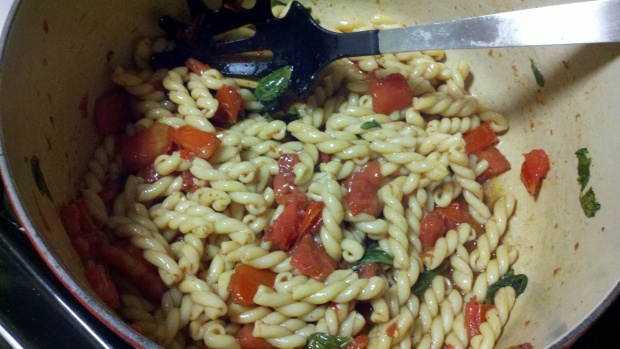
A jar of charred chili barbecue sauce
I finally had the chance to check out the Del Ray Farmers’ market this weekend, and came home with a large haul of locally-grown vegetables and fruit.
The corn turned out to be a dud, but the rest was great. I was most excited about the chili peppers. After the great luck I’d had canning corn salsa, I was hoping for a repeat performance. My canning book included what sounded like a delicious homemade barbecue sauce.
The sauce turned out perfectly; I soon found myself hovering over the pot, eating it by the spoonful.
The canning? Not so much. A few days after canning, I noticed that the jars were filled with bubbles. Uh oh.
A telltale sign of a canning project gone wrong is when the food starts to look carbonated (unless, of course, you’re making homemade sparkling wine or cider — but that’s for another blog). Canning is completely safe as long as you’re smart about it, but sometimes, it just doesn’t work. This is one of those times, and I would certainly try again.
Regardless, the sauce itself is fantastic, and keeps for up to three weeks in the refrigerator.
Charred Chili Barbecue Sauce
Adapted from Put ’em Up! cookbook, by Sherri Brooks Vinton
Yield: about 4 pints
1 lb red chili peppers
Olive, canola or grapeseed oil
5 lbs tomatoes (I used a variety of red heirlooms)
1 lb yellow onions, chopped
2 c brown sugar, lightly packed1 1/2 c cider vinegar
2 garlic cloves, inced
1 T ground allspice
1 T salt
Preheat a grill or broiler. Lightly brush clean, dry chilies with oil. Place the chilies 3-4 inches under the broiler or over the hottest part of the fire. Allow the peppers to char to black in spots, turning as necessary to char all surfaces. Remove and place in a heatproof bowl. Cover with a plate or lid for 5 minutes. (Do not leave covered for longer, or the peppers will continue to cook in their own steam.) Remove the bowl cover and allow the peppers to cool to room temperature. Slip off the skins and remove seeds and stems. Roughly chop the peppers.
Peel, core and chop the tomatoes. Combine all ingredients in a large nonreactive saucepan, cover, and bring to a boil. Remove the cover, reduce the heat, and simmer for 60-90 minutes, until sauce is thickened. Puree with a stick blender.
If refrigerating, ladle into bowls or jars. Cool, cover, and refrigerate up to 3 weeks.
For canning, use the boiling-water method. Ladle into clean, hot pint canning jars, leaving 1/4 inch of head space. Release trapped air. Wipe the rims clean; center lids on the jars and screw on jar bands. Process for 20 minutes. Turn off heat, remove canner lid, and let jars rest in the water for 5 minutes. Remove jars and set aside for 24 hours. Check seals, then store in a cool, dark place for up to 1 year.
 Up to this point, I’d eaten fresh figs exactly once in my life: when the “gourmet fruit of the month” a vendor sends to my office was black mission figs. I managed to snag a couple of those plum beauties, and I could immediately see why my fellow foodies were so enamored. That was nearly a year ago, and I hadn’t seen figs in a grocery store since.
Up to this point, I’d eaten fresh figs exactly once in my life: when the “gourmet fruit of the month” a vendor sends to my office was black mission figs. I managed to snag a couple of those plum beauties, and I could immediately see why my fellow foodies were so enamored. That was nearly a year ago, and I hadn’t seen figs in a grocery store since.
